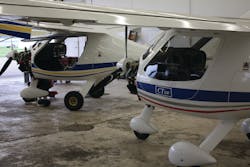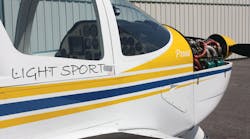My friend Doug Hereford, an A&P/IA with a particular interest in the development of maintenance practices under the Light Sport ASTM Consensus Standards, contacted me after the publication of my article in the July 2012 issue of Aircraft Maintenance Technology magazine, “Opportunity With Light Sport Aircraft Maintenance Under the ASTM Consensus Standards,” a primer on the ASTM LSA Consensus Standards system.
Hereford took issue with several statements made in my article about the extent of manufacturer authority to dictate who is authorized to perform maintenance and when such maintenance must be performed. It is his position that S-LSA manufacturers are overstepping their authority in these areas, and creating safety concerns in the process.
Since Hereford’s well-researched and articulated ideas on this topic have been accepted in principal by the FAA Office of Legal Counsel, I thought it worthwhile to bring them to the attention of the AMT community. While this controversy is far from definitively resolved, at this point I am inclined to believe that Doug has it right.
Background: Conflicting legal authority
We are all familiar with the Federal Aviation Regulations, adopted pursuant to an administrative rule-making process authorized by Congress to implement the powers granted by it to the FAA. We might not be as familiar with the origin of the ASTM Consensus Standards.
Two federal laws, also adopted by Congress, encourage the use of industry-developed consensus (voluntary) standards in federal government regulatory and procurement activities. These are the National Institute of Standards and Technology Act (NISTA), and the National Technology Transfer and Advancement Act (NTAA). The ASTM Light Sport Aircraft Consensus Standards were developed pursuant to these federal laws.
Consensus standards adopted through this process are not approved by the FAA, but are instead “accepted.” (FAA personnel sit on the various committees and participate in development of the standards.)
You can already see how things are starting to get murky. Perhaps none of this would make a difference in practice if it were not for the stark conflicts in terminology and directives contained in relevant FARs and consensus standards. An FAA Office of Legal Counsel letter released Feb. 27, 2012, appears to settle the issues in favor of the FARs. But since this opinion came as a surprise to many in the S-LSA community and appears to contradict at least the spirit of the consensus standards movement as well as the explicit language of the relevant standards, both of which envision a system of manufacturer-controlled maintenance, it is fair to say that these questions are not finally resolved. Future legislation, rule-making or both is likely, if only to clarify the situation.
The details: The who, when, and how of S-LSA maintenance
The opinion expressed in the FAA OLC letter is straight-forward: FARs trump consensus standards since FARs are adopted pursuant to the familiar rule-making procedure, and the consensus standards are not “approved” by the FAA, but only “accepted.” So, here’s what the FARs say, despite contrary language in the consensus standards.
Definitions
We’re in trouble from the beginning. For example, FAR 1.1 defines Major repair as a repair (1) that, if improperly done, might appreciably affect weight, balance, structural strength, performance, powerplant operation, flight characteristics, or other qualities affecting airworthiness; or (2) that is not done according to accepted practices or cannot be done by elementary operations. Major alteration is similarly defined.
But ASTM Consensus Standard F2626 defines these terms as any repair, alteration, or maintenance for which instructions to complete the task are excluded from the maintenance manuals supplied to the consumer. Minor repair, alteration, or maintenance, terms not defined in the FARs, are defined in F2626 as any such activity for which instructions are provided in the maintenance manuals supplied to the consumer.
There are other examples of trouble arising from terms found in the consensus standards that have no similar counterpart in the FARs, or found there, but defined substantially differently. Take, for instance, the terms heavy maintenance, line maintenance, and overhaul. F2626 defines these as follows:
heavy maintenance: any maintenance, inspection, repair or alteration a manufacturer has designated that requires specialized training, equipment or facilities;
line maintenance: any repair, maintenance, scheduled checks, servicing, inspections or alterations not considered heavy maintenance that is approved by the manufacturer and is specified in the manufacturer’s maintenance manual; and
overhaul: maintenance, inspections, repairs, or alterations that are only to be accomplished by the original manufacturer or a facility approved by the original manufacturer of the product.
These terms the first two of which are unrecognized in the FARs, become important when we look at the authority of AMTs under the FARs to conduct such procedures, and the efforts on the part of S-LSA manufacturers to limit their authority. The third term, “overhaul,” has a well-established definition familiar to AMTs, found in FAR 43.2, that is very different from the ASTM definition.
While these two maintenance systems can co-exist in the industry, it would be much easier on field technicians if the same terms were at least consistently defined.
AMT authority: FARs vs. consensus standards
In Doug Hereford’s view, apparently shared by the FAA lawyers, you don’t have to look past the provisions of Parts 43, 65 and 91 to answer the who, when, and how questions of aircraft maintenance, whether it’s type-certificated Standard Category aircraft, or S-LSAs with their Special-Light Sport Aircraft airworthiness certificates. Under this view, except for the how questions, restrictions on AMT authority found in the ASTM consensus standards, manufacturers’ maintenance manuals or other instructions, or experience and training requirements specified by manufacturers, to the extent that they conflict with or purport to limit the authority granted under the FARs, are simply invalid and may be ignored by the AMT in the field.
More to come
Next month we will take a brief look at a few specific FARs to flesh this view out. We’ll also offer some suggestions on what an AMT is to do in this confused situation.
Ed Leineweber is an aviation and business attorney practicing in Madison, WI. He is a CFII and holds the LSRM certificate. A retired Wisconsin Circuit Court Judge, he previously operated two FBOs and managed both airports. He is an incurable Bowers Fly Baby aficionado; currently completing a Fly Baby project and restoring a nearly 50-year-old Fly Baby. Ed regularly writes a SP/LSA column for the Midwest Flyer Magazine. He can be reached at [email protected] and (608) 604-6515.




